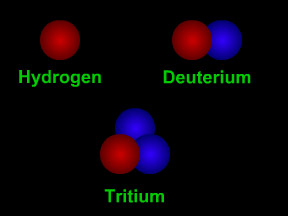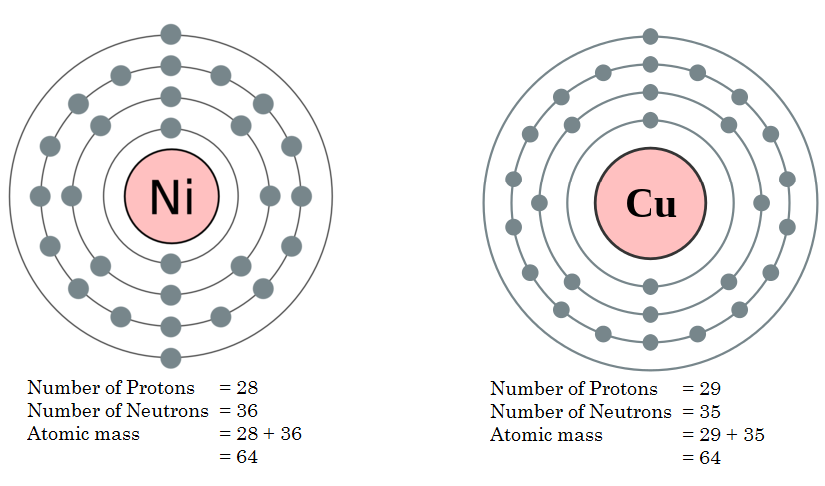
For example, 24 O has a half-life of 61 ms. The most common decay mode for isotopes lighter than the stable isotopes is β + decay (to nitrogen) and the most common mode after is β − decay (to fluorine). Oxygen-13 is an unstable isotope of oxygen. Every chemical element has one or more radioactive isotopes. For example, hydrogen, the lightest element, has three isotopes with mass numbers 1, 2, and 3. Only hydrogen-3 (tritium), however, is a radioactive isotope, the other two being stable. More than 1,000 radioactive isotopes of the various elements are known.

A family of people often consists of related but not identical individuals. Elements have families as well, known as isotopes. Isotopes are members of a family of an element that all have the same number of protons but different numbers of neutrons.
The number of protons in a nucleus determines the element’s atomic number on the Periodic Table. For example, carbon has six protons and is atomic number 6. Carbon occurs naturally in three isotopes: carbon 12, which has 6 neutrons (plus 6 protons equals 12), carbon 13, which has 7 neutrons, and carbon 14, which has 8 neutrons. Every element has its own number of isotopes.
- Radioactive isotopes may also be classified as stable isotopes when their half-lives are too long to be measured. These elements can often be found to occur in nature and include isotopes of carbon, nitrogen, hydrogen, oxygen, noble gases and metals. For example, there are a lot of carbon atoms in the universe. The normal ones are carbon-12.
- Isotope Examples The common examples are the isotopes of hydrogen and carbon. If we talk about the element Hydrogen, it has three stable isotopes namely protium, deuterium, and tritium. These isotopes have the same number of protons but a different number of neutrons wherein protium has zero, deuterium has one and tritium has two.
.svg/384px-Decay_Chain(4n%2B1%2C_Neptunium_Series).svg.png)
The addition of even one neutron can dramatically change an isotope’s properties. Carbon-12 is stable, meaning it never undergoes radioactive decay. Carbon-14 is unstable and undergoes radioactive decay with a half-life of about 5,730 years (meaning that half of the material will be gone after 5,730 years). This decay means the amount of carbon-14 in an object serves as a clock, showing the object’s age in a process called “carbon dating.”
Isotopes have unique properties, and these properties make them useful in diagnostics and treatment applications. They are important in nuclear medicine, oil and gas exploration, basic research, and national security.
DOE Office of Science & Isotopes
Isotopes are needed for research, commerce, medical diagnostics and treatment, and national security. However, isotopes are not always available in sufficient quantities or at reasonable prices. The DOE Isotope Program addresses this need. The program produces and distributes radioactive and stable isotopes that are in short supply, including byproducts, surplus materials, and related isotope services. The program also maintains the infrastructure required to produce and supply priority isotope products and related services. Finally, it conducts research and development on new and improved isotope production and processing techniques.
Isotope Facts
- All elements have isotopes.
- There are two main types of isotopes: stable and unstable (radioactive).
- There are 254 known stable isotopes.
- All artificial (lab-made) isotopes are unstable and therefore radioactive; scientists call them radioisotopes.
- Some elements can only exist in an unstable form (for example, uranium).
- Hydrogen is the only element whose isotopes have unique names: deuterium for hydrogen with one neutron and tritium for hydrogen with two neutrons.
Resources and Related Terms
- National Isotope Development Center (Isotope Basics)
Scientific terms can be confusing. DOE Explains offers straightforward explanations of key words and concepts in fundamental science. It also describes how these concepts apply to the work that the Department of Energy’s Office of Science conducts as it helps the United States excel in research across the scientific spectrum.
Examples Of Radioactive Isotopes In Society
| Symbol | Examples | ||||||
|---|---|---|---|---|---|---|---|
| name-A | carbon-12 | ||||||
| ASymbol | 12C | ||||||
|
|
⚛ natural (found in nature)
⚛ man made (artificial or synthetic)
 Isotopes can also be classified as stable or unstable:
Isotopes can also be classified as stable or unstable: Isotopes Examples Worksheets

⚛ A stable isotope does NOT undergo radioactive (or nuclear) decay.
Isotopes Examples List
⚛ An unstable isotope undergoes radioactive (or nuclear) decay.
Unstable isotopes are also known as radioisotopes or radionucleides
